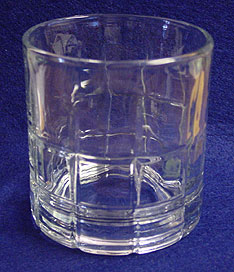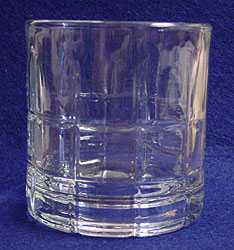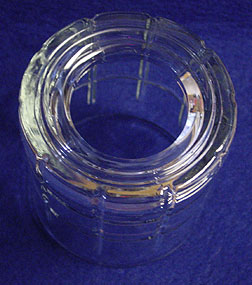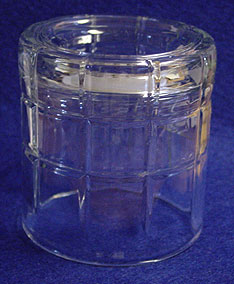 Here is the finished glass from
two side views.
Here is the finished glass from
two side views. 
Recently this effect has been revivied with the necessary gimmicks supplied along with a new fast-paced routine. Some discussion has revolved around the glass supplied and its effectiveness especially for close up work.
The glass supplied is adequate and will do the job; but being the perfectionist that I am, I was interested in seeing if something more versatile might be made.
In order to improve things it was necessary to examine the strengths and drawbacks of the original glass:
Strengths...
1. Clear so that contents might easily be seen.
2. The glass is real glass so that a good loud sound would be heard when the walnuts hit the sides of the glass.
3. Size is appropriate.
4. Slightly offset hole.
Drawbacks...
1. The white frosted walls of the hole were very apparent when the glass was viewed from the side.
2. To be effective the glass bottom needed to be at or slightly above spectators' eye level to avoid their noticing the hole.
3. Glass is too clear - allowing too good a view of walnuts.
Plans for improvement...
1. The base of the glass to be modified will have a recessed bottom so that effective angles of view may be improved.
2. The walls of the hole will be polished to resemble the sides of a recessed bottom.
3. Hole will be slightly offset to provide a good inside ledge (on one side) to catch walnuts but allow maximun hole size (1 3/4") for introducing walnuts into the glass.
4. Hole rims will be slightly beveled to resemble insides of glass and recessed bottom. Bottom bevel will be much larger to improve sight angles.
5. Walls of glass itself will have cuts or pressed in pattern to very slightly distort view of walnuts (helps disguise walnut gimmick).
6. Maintain real glass for sound effect.
Results...
 Here is the finished glass from
two side views.
Here is the finished glass from
two side views. 
 This is a performer's view of
the hole in the glass.
This is a performer's view of
the hole in the glass. 
